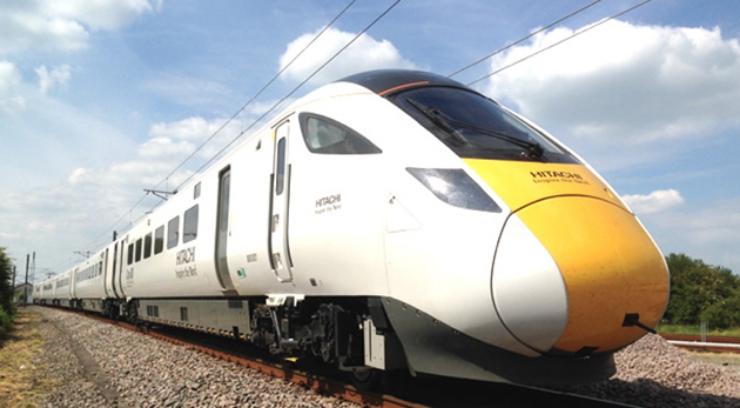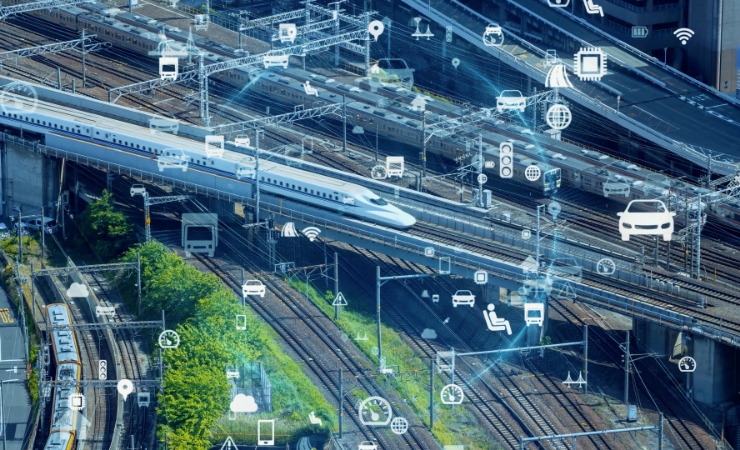- TOP
- Job Matching Navigator
- Hitachi Railway systems solution

Department for Job Matching
Hitachi, Ltd.

Railways are expected to be a solution to social issues such as global warming and the concentration of population in cities, and new construction and renewal is progressing around the world. Hitachi supports railways as a comprehensive systems integrator that provides a full line of services, including rolling stock, drive units, operation management systems, power management systems, and information services. In addition, we are actively involved in railway projects not only in Japan but also in Europe, Asia, and other overseas regions.
Design and development of high-speed rolling stock such as Shinkansen and limited express trains, commuter trains, monorails, air conditioning and ventilation systems, bogies, etc.
Design and development of VVVF inverter control devices, hybrid drive systems, network signal control systems, digital ATC, ATI, operation management systems, passenger guidance systems, substation systems, etc.
Quality assurance for high-speed rolling stock such as Shinkansen and limited express trains, commuter trains, monorails, air conditioning and ventilation systems, bogies, etc.
Quality assurance for VVVF inverter control devices, hybrid drive systems, network signal control systems, digital ATC, ATI, operation management systems, passenger guidance systems, substation systems, etc.
Development of production engineering related to the manufacture of high-speed rolling stock such as Shinkansen and limited express trains, commuter trains, monorails, air conditioning and ventilation equipment, bogies, etc.
Project engineering for VVVF inverter control equipment, hybrid drive systems, network signal control systems, digital ATC, ATI, operation management systems, passenger guidance systems, substation systems, etc.
EPlanning and development of IT services for internal railway solutions
EPlanning, development and operation of IT services for works that are responsible for everything from the design to the manufacture of railway vehicles
Development, design, manufacture and testing of high-speed rolling stock such as Shinkansen and limited express trains, commuter trains, monorails, air conditioning and ventilation systems for rolling stock, bogies, etc.

Development, design, manufacture and testing of VVVF inverter control devices, hybrid drive systems, network signal control systems, digital ATC (automatic train control), ATI (autonomous train integration), operation management systems, passenger guidance systems, and substation systems for railways.

In next-generation Shinkansen train technology, we are developing new technologies that aim to reduce noise and vibration, save energy, reduce weight, and improve maintainability, while meeting the needs for higher speeds and more frequent services.
A-train uses lightweight aluminum materials to provide a body that is easy to reuse and recycle. Friction stir welding technology is used to create a beautiful body, and the modular structure improves production efficiency and flexibility.
Battery-powered trains can run on non-electrified sections using the power stored in the batteries, making them environmentally friendly. They also reduce noise and improve ride quality by using an electric power system.
In pursuit of energy efficiency and higher performance in railway vehicles, we are using SiC power devices to achieve both a smaller, lighter device and reduced power loss. This contributes to the development of railway vehicles with a low environmental impact.
This system reduces fuel consumption in non-electrified sections, thereby reducing CO2 emissions. It is also possible to operate the train efficiently by recovering energy in the lithium-ion battery during deceleration and reusing it during acceleration. Noise is also reduced by appropriately controlling the engine's power generation and stopping the engine when the train is stationary or coasting.
An information network is built within the train, and devices such as the drive control system and brake system are managed and controlled. It also controls services such as the display of operational information, air conditioning, in-train LCD displays, and automatic public address systems. Furthermore, it is used to improve the efficiency of maintenance work and the accuracy of fault analysis through functions such as automatic testing linked to self-diagnostic functions and the recording of operational histories.
This is a device that automatically controls train speed based on train location information, ensuring safe operation while maintaining a safe distance from preceding trains. Brake control is also digitalized, and the stopping position signal is transmitted from the ground, enabling stable train operation and improving ride quality, as well as increasing transport capacity by shortening the distance between trains.
These are international standard train signaling systems. Hitachi was the first Japanese company to obtain CBTC's highest safety level certification, and has commercialized on-board signaling equipment that complies with ETCS. This means that we have adapted the technology we have cultivated in Japan to European standards, and are providing internationally safe railway systems.
This system monitors the status of trains on the line and controls them so that they run according to the timetable. When the timetable is disrupted, it supports the rapid reorganization of operations, and by monitoring and controlling connections between stations, power and station facilities, it ensures stable transport. This system also contributes to improving passenger services.
Hitachi has been providing substation systems that achieve disaster prevention, energy conservation, labor saving, and space saving, and that offer highly reliable railway power supply equipment.
The global railway market is expected to continue to grow, and Hitachi's Railway Business Unit sees this as a business opportunity and is actively expanding into overseas markets. In 2015, we acquired AnsaldoBreda and Ansaldo STS in Italy, securing bases in Europe, the Americas, and other regions. This has enabled us to expand our product lineup and strengthen our turnkey solutions and IoT/digital businesses. At present, many projects are underway not only in Europe but also in the Americas, Asia, and emerging countries, and we are seeking diverse human resources who can play an active role globally with the aim of becoming a leading company in the railway systems business.

News releases are posted on the web for major topics. In addition, we also introduce Hitachi's railway-related information on YouTube, so please take a look.